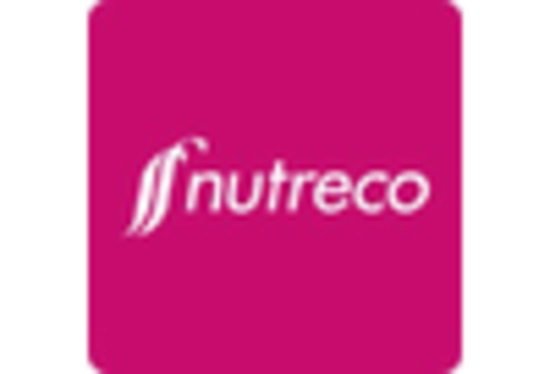Rising Aquaculture Demand
The Fish Feed Market is experiencing a notable surge in demand due to the increasing popularity of aquaculture. As populations grow and dietary preferences shift towards seafood, aquaculture emerges as a vital source of protein. In 2025, the aquaculture sector is projected to contribute significantly to global fish production, with estimates suggesting that it could account for over 50% of total fish supply. This rising demand for farmed fish directly influences the Fish Feed Market, as aquaculture operations require high-quality feed to ensure optimal growth and health of fish. Consequently, feed manufacturers are compelled to innovate and expand their product offerings to meet the specific nutritional needs of various fish species, thereby driving market growth.
Sustainability Initiatives
Sustainability has become a cornerstone of the Fish Feed Market, as consumers and producers alike increasingly prioritize environmentally friendly practices. The shift towards sustainable aquaculture practices is prompting feed manufacturers to explore alternative ingredients that reduce reliance on traditional fishmeal and fish oil. In 2025, it is anticipated that the market for sustainable fish feed will grow, with a focus on plant-based proteins and by-products from other industries. This transition not only addresses environmental concerns but also aligns with consumer preferences for responsibly sourced seafood. As a result, companies that invest in sustainable feed formulations are likely to gain a competitive edge in the Fish Feed Market, appealing to eco-conscious consumers and meeting regulatory standards.
Health and Nutrition Awareness
The growing awareness of health and nutrition is significantly influencing the Fish Feed Market. As consumers become more health-conscious, there is an increasing demand for fish that are raised on nutritionally balanced feeds. This trend is prompting feed manufacturers to invest in research and development to create feeds that enhance the nutritional profile of farmed fish. In 2025, it is projected that the demand for specialized feeds, such as those enriched with omega-3 fatty acids and vitamins, will rise. This focus on health and nutrition not only benefits consumers but also supports the overall growth of the Fish Feed Market, as producers seek to differentiate their products in a competitive marketplace.
Regulatory Support for Aquaculture
Regulatory support for aquaculture is playing a crucial role in shaping the Fish Feed Market. Governments worldwide are recognizing the importance of aquaculture in ensuring food security and are implementing policies that promote sustainable practices. In 2025, it is expected that favorable regulations will encourage investment in aquaculture, leading to increased production and, consequently, a higher demand for fish feed. This supportive regulatory environment may also facilitate research initiatives aimed at improving feed efficiency and sustainability. As a result, the Fish Feed Market stands to benefit from enhanced collaboration between government bodies and private sector stakeholders, fostering innovation and growth in the sector.
Technological Advancements in Feed Production
Technological advancements are reshaping the Fish Feed Market, enhancing production efficiency and feed quality. Innovations such as precision nutrition, automated feeding systems, and advanced processing techniques are becoming increasingly prevalent. These technologies enable manufacturers to optimize feed formulations, ensuring that they meet the specific dietary requirements of various fish species. In 2025, the integration of artificial intelligence and data analytics in feed production is expected to further streamline operations, reduce waste, and improve overall feed performance. As a result, companies that adopt these technologies may experience increased profitability and market share within the Fish Feed Market, as they can offer superior products that cater to the evolving needs of aquaculture.


















Leave a Comment